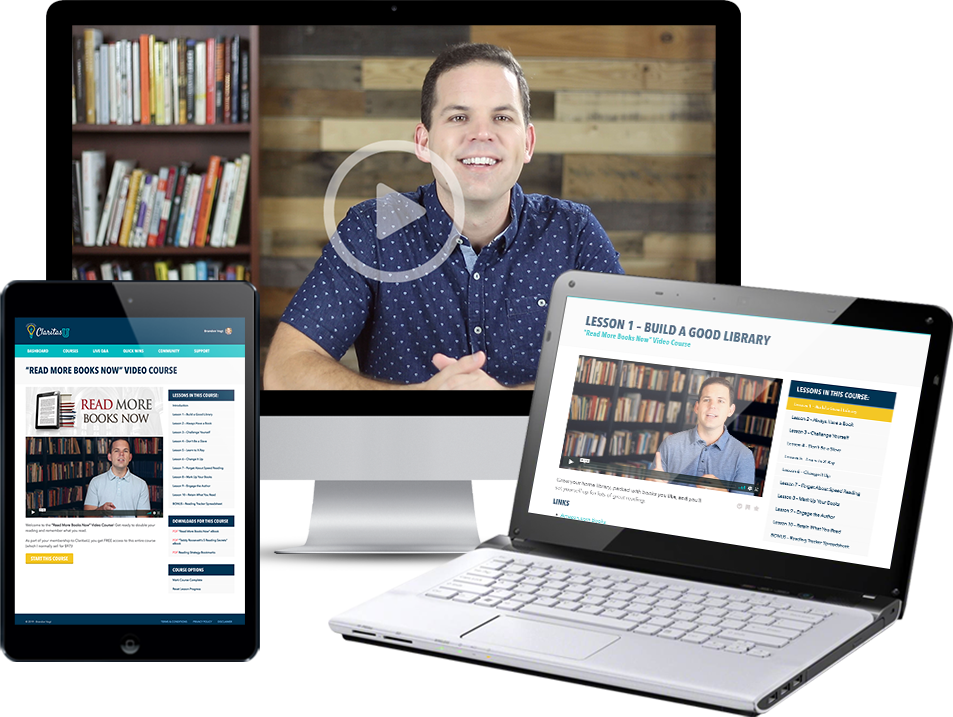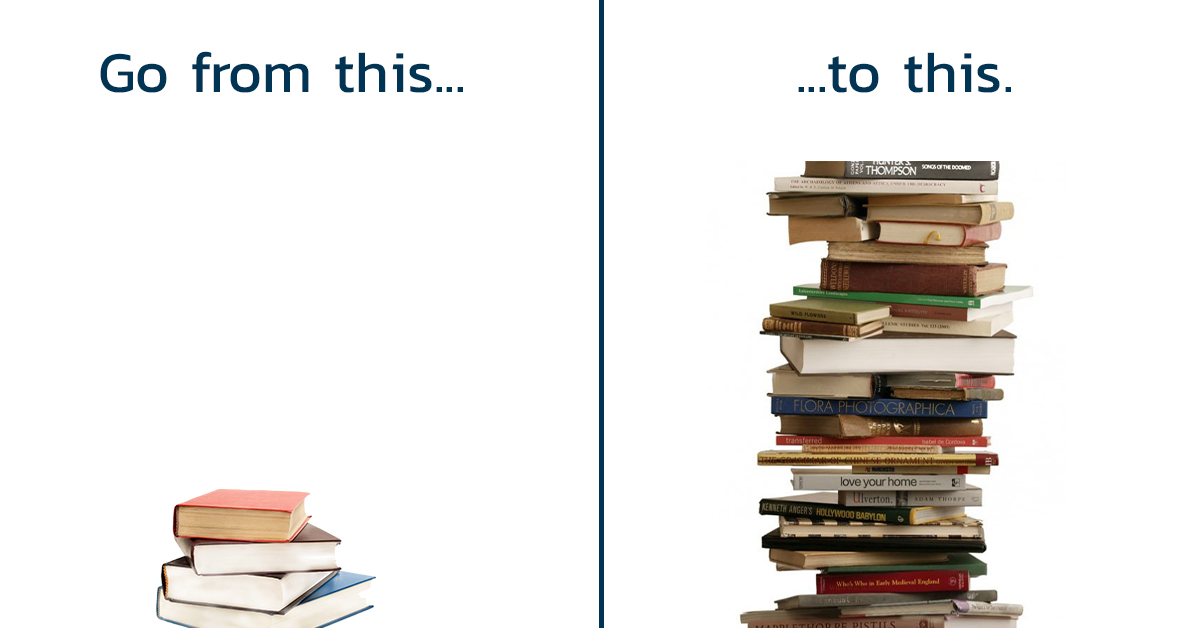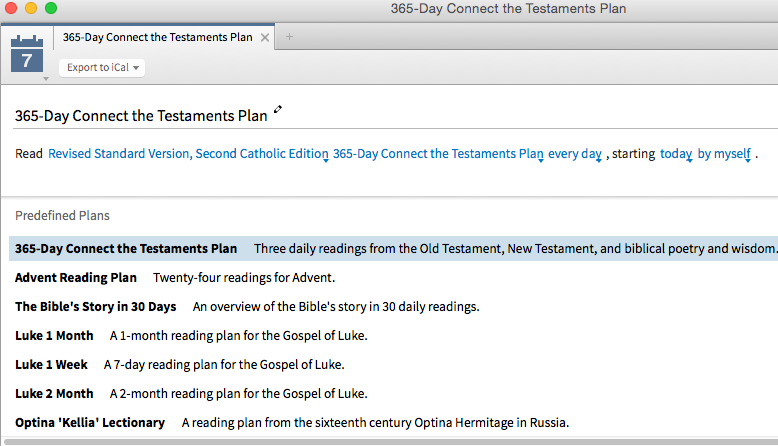Each year, I publish a version of this post, and it's one of my great delights to receive messages 12 months later from people excitedly telling me that over the past year, they finally accomplished a lifelong goal: they read the whole Bible. It’s so encouraging!
So, as you prepare for the new year, why not do it yourself?
Why not commit to reading the entire Bible in 2020? It’s not as hard as you might think.
There’s really only one secret to accomplishing the goal:
Ha! But, seriously:
The Bible contains around 775,000 words, and the average adult reads 250 words per minute. Even adding a little cushion, that means if you read the Bible for just 10-15 minutes per day, you’ll get through the whole thing in a year!
Everyone can find 10-15 minutes in their day, whether early in the morning, during a lunch break, or before going to bed.
But after committing to reading the whole Bible, most people have two questions: which translation should I use, and how should I structure the readings?
Which Translation to Use?
There are a few things to keep in mind with translations. First, make sure your Bible is complete. Protestant translations such as the New International Version (NIV), the English Standard Version (ESV), and the King James Version (KJV) do not contain the seven deuterocanonical books that the Catholic Church accepts as Sacred Scripture. You’re going to want those books in your Bible (they’re really good!) so get a Catholic Church-approved translation, one that has 73 books, not 66 books, as in most Protestant versions.
Second, you want to make sure your Bible translation strikes a good balance between precision and readability. Paraphrase translations, such as The Message, helped me tremendously as a young Christian, trying to understand the main contours of the Bible for the first time. But if you’re somewhat mature in your faith, you should seek a more literal (i.e., “word for word”) translation, one that you still find easy to read and understand.
Here are my personal recommendations, in order of preference. All of them have been officially approved by the Catholic Church for personal study:
- Revised Standard Version – 2nd Catholic Edition (RSV-2CE) – This is the one I use, and it’s preferred by most Catholic Bible scholars I know. It offers a literal but still very readable translation.
- New American Bible – Revised Edition (NAB-RE) – This is the Bible translation used at Mass, so you’ll read the same phraseology as heard in the liturgy, but it does contain some questionably translated passages and some dubious footnotes. But if you want to sync your reading to the liturgy, this is your best choice.
- New Revised Standard Version (NRSV-CE) – This is a solid, very readable translation and the first one I usually recommend to people new to the Bible. It tones down some of the more formal “thees/thous,” which some people find off-putting, however it also contains gender-inclusive language, changing “brothers” to either “friends” or “brothers and sisters.” The vertical language is fine, as God is never referred to with feminine or gender-neutral pronouns, but the horizontal language has been adjusted so if that bothers you, you might want a different translation.(
- Douay-Rheims Version (DR) – This was the standard Bible for English-speaking Catholics from 1609 until the twentieth century. It’s a trusted version preferred by many traditionalist Catholics, but while some readers find the language elegant, others find it a bit turgid, especially for daily reading.
Beside just buying a standard Bible, you might make things easier on yourself with a study Bible that is specifically designed for a one-year reading plan. For instance, there’s the My Daily Catholic Bible (NAB) which divides all of Scripture into 365 segments, one for each day of the year. It features two small readings for each day, one from the Old Testament and one from the New Testament, along with an insightful quote from a saint. The best part is that the readings are all grouped together sequentially so you don’t have to flip back and forth each day between the Old and New Testaments.
Or there’s the Bible in a Year, recently published by the Augustine Institute. It follows a similar plan—daily readings from the Old Testament, Wisdom Literature, and New Testament, arranged sequentially so you don’t have to flip around—followed by a short reflection.
Finally, there’s the Catholic One Year Bible which uses the Catholic Living Bible translation, a less-then-literal translation but one that many readers find breezier and more accessible.
In the end, what matters most is that you find a translation you’ll actually read. If you pick one that is cumbersome or inaccessible, then it doesn’t really matter whether it’s accurate. Your best bet is to sample a few translations online and then choose one you feel most comfortable reading each day.
What's the Best Plan?
Similar to the translation question, the answer here is whichever plan you’ll follow. Unfortunately, many people figure they’ll just start with Genesis and plow right on through to Revelation. That’s a bad idea. As anyone who has tried this knows, some of the early Old Testament books are meticulous and dry, such as Leviticus and Numbers, and most people get bogged down there, wiping out before finishing even half the Old Testament.
What’s a better strategy? Follow a carefully designed reading plan that will serve you the right parts of Scripture, at the right pace, and at the right time. Some of these plans alternate between Old and New Testament readings, while some also intersperse the Psalms throughout the year to add variation.
Here are some of my favorite Bible reading plans for Catholics. Choose your Bible translation, then choose a plan, and you’ll be ready to make 2018 the year you finally finish the whole Bible:
Read the Bible and the Catechism in a Year – This plan, created by the Coming Home Network, is my favorite. Not only does it take you through the whole Bible (the Catholic Bible, including the deuterocanonical books), but it also gets you through the entire Catechism of the Catholic Church. Each day you read about three chapters of Scripture and fifteen paragraphs of the Catechism. It will take you about 30 minutes each day, but then at the end of the year, you will have finished the Bible and the Catechism—you’ll know more about your faith than 99% of fellow Catholics. (Note: To get the PDF of this plan, you have to enter your email address, but it’s definitely worth it.) I’ve used this plan twice now and it’s become such a life-giving spiritual discipline.
(On a side note, my friend Dr. Chris Kaczor has a wonderful book titled 365 Days to Deeper Faith: The Catechism of the Catholic Church in Short Daily Readings, which if you only want to focus on the Catechism next year, does just what the title suggests.)
Dr. Mary Healy’s Read the Bible in a Year Plan – This plan was created by Dr. Mary Healy, the esteemed Catholic biblical scholar, and it’s great because it has you reading excerpts from the Old Testament, Psalms, and New Testament each day. That means when you get to the difficult Old Testament sections, you’ll still have the Psalms and New Testament to balance you out.
CatholicBibleInAYear.org Reading Plan – This one is similar to Dr. Healy’s plan except it offers even more variety each day. You’ll read two Old Testament readings, one New Testament reading, and one psalm each day.
Pierced Hands Reading Plan – My friend Meg Hunter-Kilmer created this plan. As Meg explains, “This one still gets you through the whole Bible in a year (and the Gospels twice), but it goes chronologically through the Old Testament (more or less) with New Testament books and fun books like Ruth and Jonah interspersed throughout to mix things up. It also gives you a chapter of some poetic stuff every day instead of dragging you through Proverbs for 200+ days. This schedule is more user-friendly, more reasonable for those who haven’t read the Bible before, and can start any day of the year.” (Meg also has a really cool Bible timeline PDF that she recommends you print and keep tucked in your Bible.)
For the Techies
I mentioned above that I prefer the Revised Standard Version – 2nd Catholic Edition (RSV-2CE) for Scripture study. But I also have a secret weapon: the Verbum Bible software.
I’ve written before about how amazing this is, calling it the most powerful Bible resource ever available. But Verbum also makes it super easy to read the Bible in a year. It does so with a built-in reading plan, right out of the box:
The best part about using Verbum is that the reading plan syncs across all of your devices. So you can read the daily Bible passages on your computer, tablet, phone, or any other mobile device. It’s great for people like me who are constantly on the go and often forget to carry around a print version of the Bible. (Verbum also syncs your highlights and notes across all devices, so the reading experience is seamless.)
To be up front, though, the Verbum library packages can be pretty expensive—the cheapest base package is $165.
But if you’re just interested in reading the Bible, the Catechism, and basic Church documents, check out the Verbum Catechism of the Catholic Church Collection. It’s only $50 and gives you lifetime access to the powerful Verbum software along with the Revised Standard Version – Catholic Edition (RSV-CE) of the Bible, the Catechism of the Catholic Church, the lectionary (the readings used at Mass), the documents of Vatican II and the Council of Trent, and a few other resources. All of those documents can be accessed on the go, on any device you’re using. In my opinion, the cost of this collection ($50) is more than worth it if it enables you to finish the Bible in a year.
(I should note that the Catechism of the Catholic Church Collection does not come with all the features of the Verbum software. It lets you read the Catechism and Bible, create reading plans, notes, highlights, and a few other things. But if you want the complete set of powerful tools in Verbum, check out one of their library packages. With those you get the full power of the software along with tons of additional books, which really showcase the power of Verbum. I personally use Verbum Master and love tools like Clause Search and Bible Facts. If you use the code BVOGT at checkout, you’ll get 10% off any Verbum library—just not the Catechism collection.
Also, full disclosure, I get a small commission if you purchase one of the Verbum libraries, but nothing if you purchase the Catechism collection. Nevertheless, I still promote the Catechism collection because I think it’s a fantastic deal and the best way to get started with Verbum.)
So those are my tips and advice. Now a question:
Are you going to read the whole Bible in 2020?
Let us know in the comment box!







